
Spring 2024 Employment Fair
Explore career possibilities at AUC's Career Fair, get the chance to network with industry leaders and pursue job opportunities.
Professor Amal Esawi ’89, ’90, the first Egyptian woman mechanical engineer to be chartered in the United Kingdom and the first scientist in Egypt to specialize in nanotubes, is making waves in the field of nanocomposites, leading a project that utilizes the power of AI to enhance water desalination membranes.
“We’re finding sustainable solutions to water scarcity through the use of novel, nano-enhanced membranes,” said Esawi, who is principal investigator of this project, which is managed by AUC's Center of Excellence for Water, funded by the United States Agency for International Development and implemented in collaboration with Ain Shams University. “AI tools, such as Artificial Neural Networks, can help us in optimizing the membrane itself and building models that predict how it will perform when operating for a long period under different conditions. Our ultimate goal is to improve and strengthen the membrane’s structure and performance, leading to a more efficient desalination process."
These nano-enhanced membranes use materials like carbon nanotubes that help increase structural integrity and filtration efficiency. They also offer better performance by aiding in capturing finer particles and enabling effective purification during the water desalination process.
Nanomaterials, particularly nanocarbons, first caught Esawi’s attention for their robustness and lightness. "My initial focus in nanotechnology was centered on utilizing carbon nanotubes to engineer lighter and stronger materials,” she explained. “Upon discovering their potential in desalination membranes, I pivoted my research toward enhancing filtration applications.”
Egypt is currently investing in desalination plants to address water scarcity in the region. Esawi asserts the need to not just innovate membranes but also localize their production to potentially reduce costs. “Because membranes are the most critical component in the desalination plant, they are imported from the United States or Japan. Building the local know-how of membrane manufacturing will be very useful and valuable for Egypt,” she said.
The two-year project is still in its early stages, but Esawi is optimistic about its potential impact on desalination technology.
“This project could lay the foundations for the local production of advanced nano-enhanced membranes, benefiting not only Egypt but also other regions facing water scarcity,” she said.
Esawi presented the project, “Using AI Tools to Optimize the Development of Novel Nano-enhanced Membranes for Water Desalination,” at the Second International Symposium on Water Research, organized by AUC’s Center of Excellence for Water in collaboration with Ain Shams University in late 2023. Mohammed El Morsi, mechanical engineering professor, and Adham Ramadan ’90, chemistry professor, dean of graduate studies and associate provost for research innovation and creativity, are co-principal investigators of the project with Esawi. El Morsi emphasized the power of membrane technology. “It has emerged as a more energy-efficient and cost-effective alternative to thermal desalination techniques,” he said. “By utilizing AI tools to optimize the process, we are hoping to further reduce energy consumption.”
Besides her innovative research in water desalination, Esawi was recognized as one of the top 2% impactful scientists globally, named in the Stanford-Elsevier's Scopus database as one of the most cited scientists. Hoping to inspire her students and other women engineers in Egypt, she expressed pride in witnessing an AUC graduate, Sarah Hussein ’07, become the second female Egyptian mechanical engineer to be chartered in the United Kingdom. “I am humbled to pave the way for aspiring engineers in Egypt, especially women,” she said.
Amal Esawi’s latest research employs AI and nano-enhanced materials to improve membranes used in desalination as a means of tackling water scarcity

AUCians across disciplines made their voices heard in Dubai, United Arab Emirates at COP28, the 2023 United Nations Climate Change Conference which is the world’s largest climate conference. Faculty, students and alumni shared their expertise on topics such as green buildings and education, showcased award-winning sustainable startups, and delivered powerful speeches. Read more about AUC at COP28 below.
Learn more about the University's Climate Change Initiative.
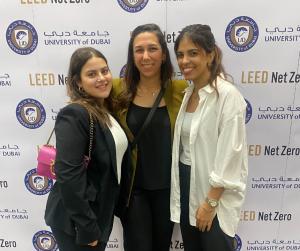
Panelist in the session, "Climate Change: Are Business Schools Doing Enough?" organized by the Association to Advance Collegiate Schools of Business and the University of Dubai
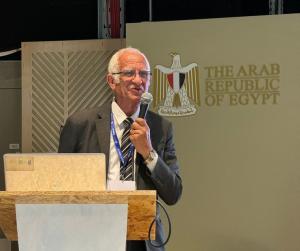
Panelist in the session, "Integrated Urban Sustainability and Social Value Creation in Cities" as well as a speaker and panelist in the session, "Sustainable Cities and Climate Change." Learn more about Haggar's pioneering sustainability work in AUCToday magazine

Presented at the Montreal Protocol Pavilion (starts at 35:21) in the session, "Energy Efficiency in the RAC Servicing Sector – A Missing Piece to Make MEPS Work," where he discussed the activities and findings of the Montreal Protocol's Refrigeration, Air Conditioning and Heat Pumps Technical Options Committee, of which he is co-chair. He also was a participant at the side event, "National Cooling Action Plans in the Arab Region."
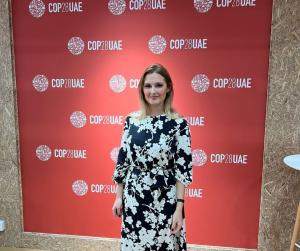
Panelist in the discussion, "Arts for Climate in Rural Areas Schools in Egypt" and interviewed by TRENDS Research & Advisory on the spread of diseases during natural disasters
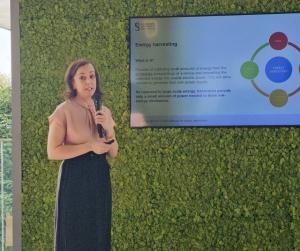
Assistant Professor of Physics, Sorbonne University Abu Dhabi
Presenter
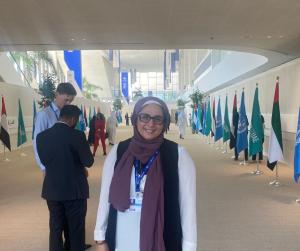
Child Protection Program Consultant, UNICEF Gulf
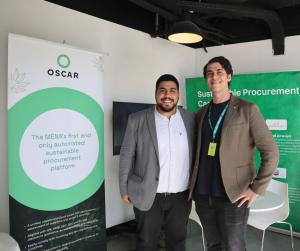
Sustainability Analyst, Oscar Limited
Exhibited a startup company in the Green Zone and organized the panel, "Sustainable Procurement: How It Can Help the UAE Meet Its Net Zero Target"
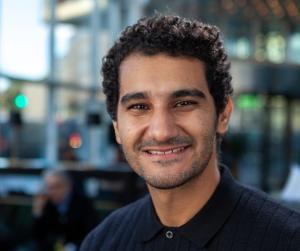
Award-Winning Film Director and Producer
Screened his short documentary, Drowning Fish, which follows one of the last fishermen of Qarun Lake in Fayoum, Egypt, at the Green Zone during a panel, "Local Storied, Global Impact" and at the Blue Zone.
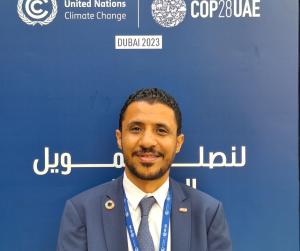
Chief Business Development and Sustainability Officer, El Marakby Steel
Panelist and promoted partnerships within the private sector as well as between NGOs and the private sector, focusing on sustainable steel production
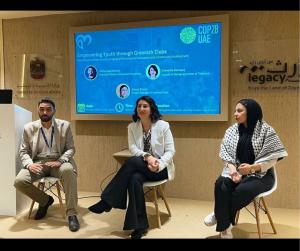
Founder and Managing Director, Tadweera
Led the panel, "Tadweera's Initiative for Green Education in Sustainable Communities"
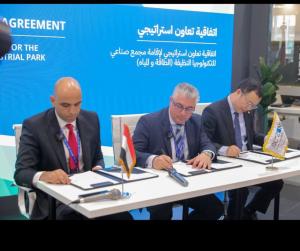
Engazaat
The Suez Canal Economic Zone (SCZONE), Engazaat and CHINT Global signed an agreement to establish and operate an integrated industrial park for green energy technology in SCZONE.
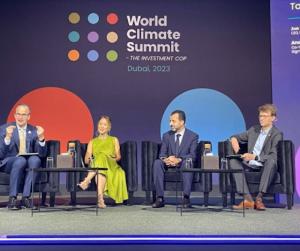
Panelist
Karim Refaat ‘98 ‘03; Manal Hassan ‘90; Dalia Kamar ‘17; Minister Rania Al Mashat ‘95,; AUC Trustee Ahmed Ismail ‘97; Amir El Shenawy ‘13; Haytham El Maagergi ‘99; Miray Zaki ‘04; Mirna Arif ‘02 ‘07; Samar Negida ‘11 ‘14; Sherif Hafez ‘99; Shereif Rostom ‘05; and Soha El Turky ‘94 ‘98

University Architect and Associate Professor of Sustainable Design
Name Among the Top 100 Middle East Sustainability Voices by Climate Penpal and Gulf Intelligence
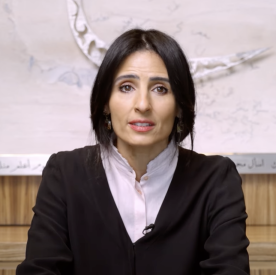
Razan Al Mubarak, UN Climate Change High-Level Champion of the United Arab Emirates for COP28, outlines why universities and colleges are so important to the Race to Zero, speaking of AUC's commitment to the cause.

A team of AUC undergraduate and graduate students secured the award for the Most Novel Idea at Heart Hackathon, the world’s first total artificial heart design competition, where student teams from around the globe design, prototype and assess their total artificial heart.
Multidisciplinary with students from different majors, Team Peribsen worked to design, manufacture and develop the business plan for their total artificial heart. They were mentored by Professor Khalil Elkhodary '03, '06 and utilized AUC's new Eltoukhy Learning Factory for Innovation and Entrepreneurship, the first of its kind in Egypt.
Aliaa Moussa, mechanical engineering; Salma Omar, graphic design; and Lana Mahmoud, electronics and communications engineering, represented AUC in the final round of the competition held in Dallas, Texas at the 29th Annual Meeting of the International Society for Mechanical Circulatory Support
Other team members included Abdelrahman Sultan '18, who is pursuing his master's in mechanical engineering at AUC and served as team captain; and team heads Ahmed Ali '23; Mohamed Waheed '22; Nour Makhlouf '23; and Menna Tallah Hassan '23.
Watch our students reflect on their total artificial heart prototype to help patients with heart failure, which won the Most Novel Idea at the global Heart Hackathon.
